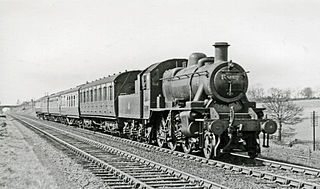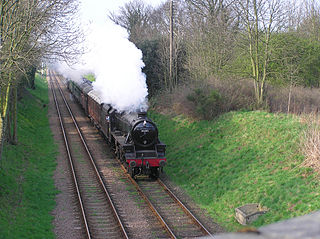Fleet
The fleet is operated by Locomotive Services.
- Royal Scot climbing Shap in April 2016 for the first time since her withdrawal in 1962
- 7MT Britannia in BR black.
- 70000 7MT Britannia in BR black.
The Royal Scot Locomotive and General Trust (RSL>) is a charitable trust set up in 2009, to enable ownership and restoration to mainline running condition of the London Midland and Scottish Railway Royal Scot Class locomotive No. 6100 Royal Scot.
The trust has since been expanded and now owns a number of mainline locomotives in various states of repair, most of which are associated with the Trust's founder, Jeremy Hosking. Furthermore, a group of companies including Locomotive Services (LSL) has been set up to encompass repair, maintenance of operation for RSL> and other assets.
The RSL> Ltd was formed in 2009 to protect for the long term, steam locomotives capable of hauling passenger trains on both the main line and heritage railways. Set up to acquire locomotive No. 6100 Royal Scot, the Trust became a registered charity in late 2011 when it acquired Great Western Railway 4-6-0 GWR 6000 Class No. 6024 King Edward I.
The Trust's stated intent is to have representative locomotives from the following railway companies:
RSL> locomotives are maintained to mainline operating standards and are operated on the mainline railways of the UK, in addition to preserved railways by Locomotive Services.
The fleet is operated by Locomotive Services.

The London Midland and Scottish Railway (LMS) Coronation Class is a class of express passenger steam locomotives designed by William Stanier. They were an enlarged and improved version of his previous design, the LMS Princess Royal Class, and on test were the most powerful steam locomotives ever used in Britain at 2,511 dbhp. The locomotives were specifically designed for power as it was intended to use them on express services between London Euston and Glasgow Central; their duties were to include the hauling of a proposed non-stop express, subsequently named the Coronation Scot. The first ten locomotives of the Coronation class were built in a streamlined form in 1937 by the addition of a steel streamlined casing. Five of these ten were specifically set aside to pull the Coronation Scot. Although a later batch of five unstreamlined locomotives was produced in 1938, most of the ensuing Coronation class were outshopped as streamliners. Eventually, from 1944 to 1949, all-new engines would be built in unstreamlined form and all the streamliners would have their casings removed. The very last of the 38 locomotives was completed in 1948.

70013 Oliver Cromwell is a British Railways Standard Class 7 preserved steam locomotive. The locomotive is notable as one of the four steam locomotives which worked the last steam railtour on British Railways (BR) in 1968.

The Nene Valley Railway (NVR) is a preserved railway in Cambridgeshire, England, running between Peterborough Nene Valley and Yarwell Junction. The line is 7+1⁄2 miles (12.1 km) in length. There are stations at each terminus, and three stops en route: Orton Mere, Ferry Meadows and Wansford.

The steam locomotives of British Railways were used by British Railways over the period 1948–1968. The vast majority of these were inherited from its four constituent companies, the "Big Four".
The London Midland Region (LMR) was one of the six regions created on the formation of the nationalised British Railways (BR), and initially consisted of ex-London, Midland and Scottish Railway (LMS) lines in England and Wales. The region was managed first from buildings adjacent to Euston station, and later from Stanier House in Birmingham. It existed from the creation of BR in 1948, ceased to be an operating unit in its own right in the 1980s, and was wound up at the end of 1992.

The Standard class 6, otherwise known as the Clan Class, was a class of 4-6-2 Pacific tender steam locomotive designed by Robert Riddles for use by British Railways. Ten locomotives were constructed between 1951 and 1952, with a further 15 planned for construction. However, due to acute steel shortages in Britain, the order was continually postponed until it was finally cancelled on the publication of the 1955 Modernisation Plan for the re-equipment of British Railways. All of the original locomotives were scrapped, but a replica is being built.

The BR Standard Class 7, otherwise known as the Britannia Class, is a class of 4-6-2 Pacific steam locomotive designed under Robert Riddles for use by British Railways for mixed traffic duties. 55 were constructed between 1951 and 1954. The design employed results from the 1948 locomotive exchanges undertaken in advance of further locomotive classes being constructed. Three batches were constructed at Crewe Works, before the publication of the 1955 Modernisation Plan.

The North British Locomotive Company was created in 1903 through the merger of three Glasgow locomotive manufacturing companies; Sharp, Stewart and Company, Neilson, Reid and Company and Dübs and Company, creating the largest locomotive manufacturing company in Europe and the British Empire.

The London, Midland and Scottish Railway (LMS) Royal Scot Class is a class of 4-6-0 express passenger locomotive introduced in 1927. Originally having parallel boilers, all members were later rebuilt with tapered type 2A boilers, and were in effect two classes.

The London, Midland and Scottish Railway (LMS) Ivatt Class 2 2-6-0 is a class of steam locomotive designed for light mixed traffic.

British Railways (BR) Standard Class 7, number 70000 Britannia is a preserved steam locomotive, owned by the Royal Scot Locomotive and General Trust.

LMS Princess Coronation Class 46233 Duchess of Sutherland is a steam locomotive built in 1938 for the London, Midland and Scottish Railway (LMS) at Crewe Works to a design by William Stanier. It is a 4-6-2 Pacific locomotive built as part of the LMS Coronation Class for its express passenger services, including the Royal Scot service from London to Glasgow.

London Midland and Scottish Railway (LMS) Royal Scot Class 6100Royal Scot is a preserved British steam locomotive.

London Midland and Scottish Railway (LMS) Jubilee Class No. 5690Leander is a preserved British steam locomotive.

London Midland and Scottish Railway (LMS) Stanier Class 5 4-6-0 No. 5305 is a preserved British steam locomotive. In preservation, it has carried the name Alderman A.E. Draper, though it never carried this in service. It was named after Albert Draper, the man who rescued the locomotive in his own scrapyard.
London Midland and Scottish Railway (LMS) Stanier Class 5 4-6-0 5231 is a preserved British steam locomotive. In preservation, it has carried the names 3rd (Volunteer) Battalion The Worcestershire and Sherwood Foresters Regiment and The Sherwood Forester, though it never carried either of these in service.

35027 Port Line was one of a batch of ten SR Merchant Navy Class steam locomotives built by the Southern Region of British Railways between 1948 and 1949.

LNER Peppercorn A2 Class No. 60532 Blue Peter is the sole survivor of 15 4-6-2 locomotives of the A2 class, designed by Arthur Peppercorn of the LNER. 60532 worked between 1948 and 1966. It is owned by the Royal Scot Locomotive and General Trust (RSL>), currently under overhaul at their LNWR Heritage facility based at Crewe.
Carnforth MPD is a former LMS railway depot located in the town of Carnforth, Lancashire.

Locomotive Services (TOC) Limited is a train operating company in Great Britain. The company operates rail tours using heritage steam, diesel and electric locomotives with support from associated companies and trusts.